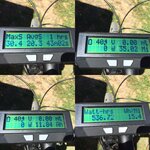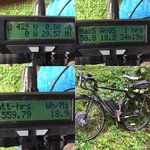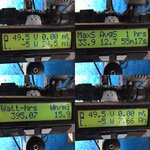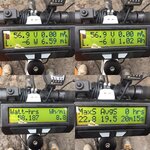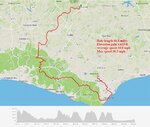Rick Speicher
Member
When shopping around for an Ebike, one of the main concerns is range. Running out of power several miles from your recharge site is a bit of a pain, and for some with disabilities, it is simply not an option. I work with a lot of different Ebikes, from high end European makes to lower priced Asian makes, and a lot of DIY stuff. And what I see is a lot of exaggerated range claims by all, some extremely exaggerated! Most folks I know state there range in terms of Watt Hours per mile, Wh/m. This seems to be a good way to compare all Ebikes, no matter the make, battery voltage or motor power. On average, I have found that I typically get about 1 mile per 20 Watt hour, 20Wh/m. This is a classic case of 'less is more', in that, 15 Wh/m is better milage than 20 Wh/m, so a lower Wh/m number is a good thing! I commute daily about 50 miles, and try as I might, being an athletic peddler, I have never gotten better than 18.7 Wh/m. Yet I see some new European makes claiming less than 5 Wh/m!!  This totally pegs my BS meter! So my question to all of the good and knowledgeable people here at EBR is, What kind of range do you get? Please share your range numbers, and please be honest, as this is an effort to help others, some with disabilities, to choose a bike that will truly deliver the range they have to have to make it home safely. For those who do not understand the math, here is how it works. Multiply the battery capacity which is usually stated in Amp Hours, Ah, by the battery voltage in volts V, to get Watt Hours, Wh.
This totally pegs my BS meter! So my question to all of the good and knowledgeable people here at EBR is, What kind of range do you get? Please share your range numbers, and please be honest, as this is an effort to help others, some with disabilities, to choose a bike that will truly deliver the range they have to have to make it home safely. For those who do not understand the math, here is how it works. Multiply the battery capacity which is usually stated in Amp Hours, Ah, by the battery voltage in volts V, to get Watt Hours, Wh.
For instance, my battery is 52v x 11.5Ah = 598 Wh. Then simply divide Wh by your mileage, 598Wh / 32miles = 18.68 Wh/m, which is my personal best. Keep in mind that this number will vary based on terrain, load and speed. I live in a steep hilly area, weigh 200+ and like to go 20mph on average, so the same setup will yield better mileage on the flats with a lighter rider going slower. What's your best ?
For instance, my battery is 52v x 11.5Ah = 598 Wh. Then simply divide Wh by your mileage, 598Wh / 32miles = 18.68 Wh/m, which is my personal best. Keep in mind that this number will vary based on terrain, load and speed. I live in a steep hilly area, weigh 200+ and like to go 20mph on average, so the same setup will yield better mileage on the flats with a lighter rider going slower. What's your best ?
